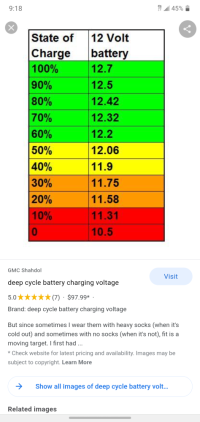HerbertFriedman
Member III
I installed a Balmar Smart Gauge a few years ago at the recommendation of the Maine Sail review. That gauge uses a proprietary set of algorithms supposedly developed by the UK Air Force which measures the Battery State of Charge by just monitoring the voltage profile during charge and discharge cycles. The more conventional approach (Victron) measures the AmpHours discharged by the battery by monitoring the current in a ground shunt. Apparently, while this method accurately measures the charge delivered by the battery, the SOC as a percent of the batteries capacity is in doubt in older batteries because the SOC when the battery is fully charged, can degrade with age, hence the SOC as a percent is in doubt. According to Maine Sail and Balmar their algorithms avoid this problem.
My problem is that with a normal set of instruments (depth, speed, chart plotter and VHF, the fridge and the auto pilot being turned off), the Balmar SOC drops from 98-100% (after days worth of shore power charging) to about 61% in the course of a 3 hour day sail. So going a short distance to an anchorage for the night means I have to run the engine to charge the batteries back up.
The house battery bank is two G27 Trojan wet cells in parallel, each one listed at 105 Amp hours for a total of 210 Amp hours, not insignificant for my E34. Both batteries are only one year old and the water level looks OK. So a difference of 98% - 61% is a charge loss of 29% which for the 210 Amp hour bank represents a charge loss of 61 Amp hours in 3 hours or an average current draw of about 20 amps. That current draw sounds quite high for the instruments and indeed, a clamp on ammeter around the current lead of the bank reads only about 5 amps. Also the battery voltage at the end measured 12.22 V, sounds about right for a fully charged battery.
Any ideas out there? I will call Balmar but when I called them a few years ago about an error message, E10, the tech said he never heard of such an error message, so I am skeptical.
My problem is that with a normal set of instruments (depth, speed, chart plotter and VHF, the fridge and the auto pilot being turned off), the Balmar SOC drops from 98-100% (after days worth of shore power charging) to about 61% in the course of a 3 hour day sail. So going a short distance to an anchorage for the night means I have to run the engine to charge the batteries back up.
The house battery bank is two G27 Trojan wet cells in parallel, each one listed at 105 Amp hours for a total of 210 Amp hours, not insignificant for my E34. Both batteries are only one year old and the water level looks OK. So a difference of 98% - 61% is a charge loss of 29% which for the 210 Amp hour bank represents a charge loss of 61 Amp hours in 3 hours or an average current draw of about 20 amps. That current draw sounds quite high for the instruments and indeed, a clamp on ammeter around the current lead of the bank reads only about 5 amps. Also the battery voltage at the end measured 12.22 V, sounds about right for a fully charged battery.
Any ideas out there? I will call Balmar but when I called them a few years ago about an error message, E10, the tech said he never heard of such an error message, so I am skeptical.

